Skip to content 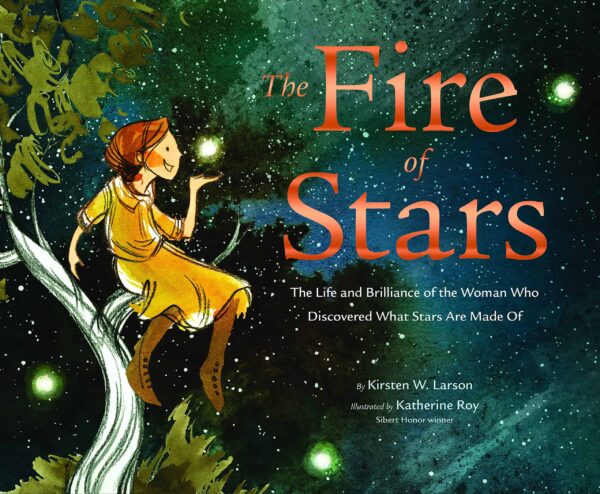
The Fire of Stars: The Life and Brillance of the Woman Who Discovered What Stars Are Made of
By Kirsten W. Larson, Illustrated by Katherine Roy
A poetic picture book celebrating the life and scientific discoveries of the groundbreaking astronomer Cecilia Payne!
Astronomer and astrophysicist Cecilia Payne was the first person to discover what burns at the heart of stars. But she didn’t start out as the groundbreaking scientist she would eventually become. She started out as a girl full of curiosity, hoping one day to unlock the mysteries of the universe. 5-8 years
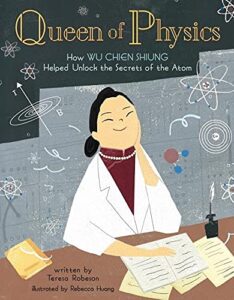
Queen of Physics: How Wu Chien Shiung Helped Unlock the Secret of the Atom
By Teresa Robeson, Illustrated by Rebecca Huang
When Wu Chien Shiung was born in China 100 years ago, most girls did not attend school; no one considered them as smart as boys. But her parents felt differently. Giving her a name meaning “Courageous Hero,” they encouraged her love of learning and science. This engaging biography follows Wu Chien Shiung as she battles sexism and racism to become what Newsweek magazine called the “Queen of Physics” for her work on beta decay.
Along the way, she earned the admiration of famous scientists like Enrico Fermi and Robert Oppenheimer and became the first woman hired as an instructor by Princeton University. The first woman elected President of the American Physical Society. The first scientist to have an asteroid named after her when she was still alive, and many other honors. 5 years +

One Step Further: My Story of Math, the Moon and a Lifelong Mission
By Katherine Johnson, Illustrated by Charnelle Barlow
This inspirational picture book reveals what is was like for a young black mother of three to navigate the difficult world of the 1950s and 60s and to succeed in an unwelcoming industry to become one of the now legendary “hidden figures” of NASA computing and space research.
Johnson’s own empowering narrative is complemented by the recollections of her two daughters about their mother’s work and insights about how she illuminated their paths, including one daughter’s fight for civil rights and another’s journey to become a NASA mathematician herself.
Filled with personal reflections, exclusive family archival photos, and striking illustrations, readers will be immersed in this deeply personal portrayal of female empowerment, women in STEM, and the breaking down of race barriers across generations. Historical notes, photo/illustration notes, and a time line put the story into historical and modern-day context. 4-8 years
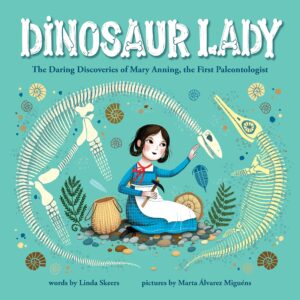
Dinosaur Lady: The Daring Discoveries of Mary Anning, The First Paleontologist
By Linda Skeers, Illustrated by Marta Álvarez Miguéns
Mary Anning loved scouring the beach near her home in England for shells and fossils. She fearlessly climbed over crumbling cliffs and rocky peaks, searching for new specimens. One day, something caught Mary’s eye.
Bones. Dinosaur Bones.
Mary’s discoveries rocked the world of science and helped create a brand-new field of study: paleontology. But many people believed women couldn’t be scientists, so Mary wasn’t given the credit she deserved. Nevertheless, Mary kept looking and learning more, making discoveries that reshaped scientific beliefs about the natural world.
Educational backmatter includes a timeline of Mary Anning’s life and lots of fantastic fossil facts! 3-8 years

The Girl With the Mind for Math: The Story of Raye Montague
By Julia Finley Mosca, Illustrated by Daniel Rieley
After touring a German submarine in the early 1940s, young Raye set her sights on becoming an engineer. Little did she know sexism and racial inequality would challenge that dream every step of the way, even keeping her greatest career accomplishment a secret for decades. Through it all, the gifted mathematician persisted―finally gaining her well-deserved title in history: a pioneer who changed the course of ship design forever. In addition to the illustrated rhyming text, you’ll find a complete biography, fun facts, a colorful timeline of events, and even a note from Montague herself! 7-10 years
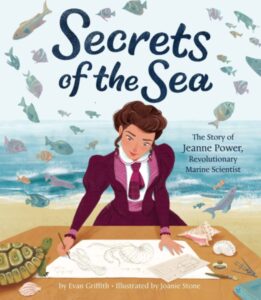
Secrets of the Sea: The Story of Jeanne Power Revolutionary Marine Scientist
By Evan Griffith, Illustrated by Joanie Stone
How did a nineteenth-century dressmaker revolutionize science? Jeanne Power was creative: she wanted to learn about the creatures that swim beneath the ocean waves, so she built glass tanks and changed the way we study underwater life forever.
Jeanne Power was groundbreaking: she solved mysteries of sea animals and published her findings at a time when few of women’s contributions to science were acknowledged. Jeanne Power was persistent: when records of her research were lost, she set to work repeating her studies. And when men tried to take credit for her achievements, she stood firm and insisted on the recognition due to her. 6-9 years
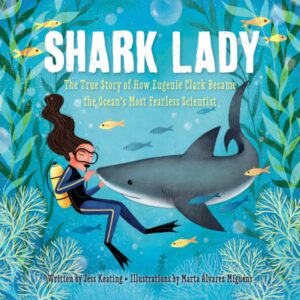
Shark Lady
The True Story of How Eugenie Clark Became the Ocean’s Most Fearless Scientist
By Jess Keating, Illustrated by Marta Álvarez Miguéns
Eugenie Clark fell in love with sharks from the first moment she saw them at the aquarium. She couldn’t imagine anything more exciting than studying these graceful creatures. But Eugenie quickly discovered that many people believed sharks to be ugly and scary―and they didn’t think women should be scientists.
Determined to prove them wrong, Eugenie devoted her life to learning about sharks. After earning several college degrees and making countless discoveries, Eugenie wrote herself into the history of science, earning the nickname “Shark Lady.” Through her accomplishments, she taught the world that sharks were to be admired rather than feared and that women can do anything they set their minds to. 3-8 years

The Story of Jane Goodall
By Susan B. Katz
Jane Goodall is a celebrated scientist for her studies of chimpanzees in the forests of Africa. Before she observed chimps and helped save them from losing their home, Jane was a curious kid who loved learning about animals. She showed people that women could be scientists, just like men, and fought to follow her dream of working with wild chimps. Explore how Jane Goodall went from being a young nature lover in England to the most important chimpanzee expert in the world. 6-9 years
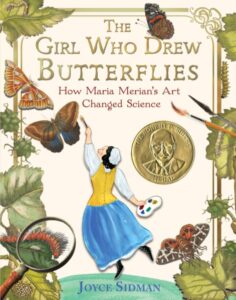
The Girl Who Drew Butterflies: How Maria Merian’s Art Changed Science
By Joyce Sidman
One of the first naturalists to observe live insects directly, Maria Sibylla Merian was also one of the first to document the metamorphosis of the butterfly.
Richly illustrated throughout with full-color original paintings by Merian herself, The Grew Who Drew Butterflies will inspire young scientists. 6-9 years

Born Curious: 20 Girls Who Grew Up to Be Awesome Scientists
By Martha Freeman, Illustrated by Katy Wu
Why do galaxies spin the way they do?
What’s the best kind of house for a Komodo dragon?
Can you cure malaria with medicine made from a plant?
The scientists and mathematicians in Born Curious sought answers to these and many other fascinating questions. And it’s lucky for us they did. Without their vision, insight, and hard work, the world would be a sicker, dirtier, and more dangerous place.
The twenty groundbreaking women—including Rosalind Franklin, Marie Tharp, Shirley Anne Jackson, and more—came from all kinds of backgrounds and had all kinds of life experiences. Some grew up rich. Some grew up poor. Some were always the smartest kid in class. Some struggled to do well in school. But all had one thing in common: They were born curious. Are you curious, too? 7-12 years
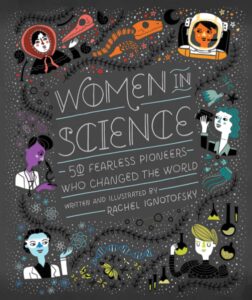
Women in Science: 50 Fearless Pioneers Who Changed the World
By Rachel Ignotofsky
It’s a scientific fact: Women rock! This fascinating, educational collection features 50 illustrated portraits of trailblazing women in STEM throughout history. Full of striking, singular art, Women in Science also contains infographics about relevant topics such as lab equipment, rates of women currently working in STEM fields, and an illustrated scientific glossary. The trailblazing women profiled include such pioneers as primatologist Jane Goodall and mathematician Katherine Johnson, who calculated the trajectory of the 1969 Apollo 11 mission to the moon.
Women in Science celebrates the achievements of the intrepid women who have paved the way for the next generation of female engineers, biologists, mathematicians, doctors, astronauts, physicists, and more! 7 years+
The book descriptions are primarily from the publishers.
If you like this post, then please consider sharing it and/or leaving a comment below. Thank you! Barbara Lowell, Children’s Author
You may like,
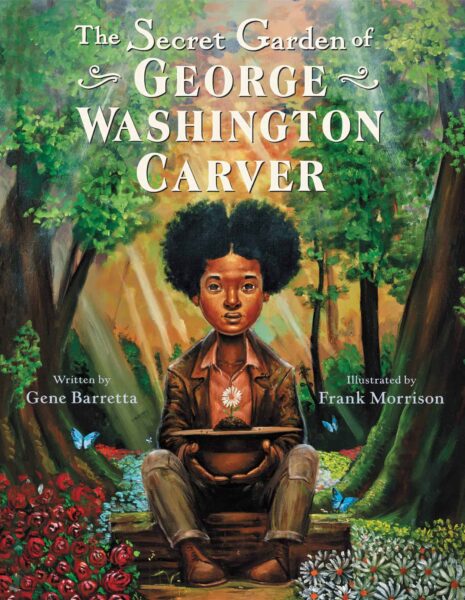
The Secret Garden of George Washington Carver
By Gene Barretta, Illustrated by Frank Morrison
When George Washington Carver was just a young child, he had a secret: a garden of his own.
Here, he rolled dirt between his fingers to check if plants needed more rain or sun. He protected roots through harsh winters, so plants could be reborn in the spring. He trimmed flowers, spread soil, studied life cycles. And it was in this very place that George’s love of nature sprouted into something so much more—his future.
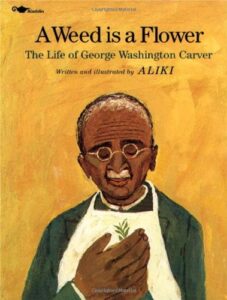
A Weed is a Flower: The Life of George Washington Carver
By Aliki
Discover how George Washington Carver went from a slave to an innovator of agricultural science in this illustrated picture book. Born a slave, he went on to become the most prominent black scientist of the early twentieth century.

I Am George Washington Carver
By Brooke Vitale
With the help of inventor, painter, musician, and botanist George Washington Carver, Brad, Xavier, and Yadina come together to learn how to take care of the Earth.

Who Was George Washington Carver?
By Jim Gigliotti, Illustrated by Stephen Marchesi
Born in 1860s Missouri, nobody expected George Washington Carver to succeed. Slaves were not allowed to be educated. After the Civil War, Carver enrolled in classes and proved to be a star student. He became the first black student at Iowa State Agricultural College and later its first black professor. He went on to the Tuskegee Institute where he specialized in botany (the study of plants) and developed techniques to grow crops better. His work with vegetables, especially peanuts, made him famous and changed agriculture forever. He went on to develop nearly 100 household products and over 100 recipes using peanuts.
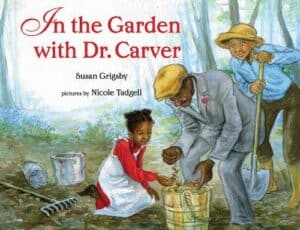
In the Garden with Dr. Carver
By Susan Grigsby, Illustrated by Nicole Tadgell
Sally is a young girl living in rural Alabama in the early 1900s, a time when people were struggling to grow food in soil that had been depleted by years of cotton production. One day, Dr. George Washington Carver shows up to help the grown-ups with their farms and the children with their school garden. He teaches them how to restore the soil and respect the balance of nature. He even prepares a delicious lunch made of plants, including “chicken” made from peanuts. Sally never forgets the lessons this wise man leaves in her heart and mind. Susan Grigsby’s warm story shines new light on a Black scientist who was ahead of his time.
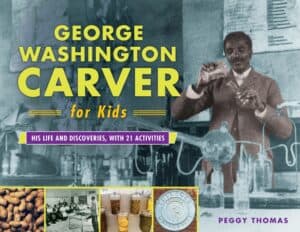
George Washington Carver: His Life and Discoveries with 21 Activities
By Peggy Thomas
George Washington Carver was a scientist, educator, artist, inventor, and humanitarian. Born into slavery during the Civil War, he later pursued an education and would become the first black graduate from Iowa Agricultural College. Carver then took a teaching position at the Tuskegee Institute, founded by Booker T. Washington. There, Carver taught poor Southern farmers how to nourish the soil, conserve resources, and feed their families. He also developed hundreds of new products from the sweet potato, peanut, and other crops, and his discoveries gained him a place in the national spotlight.
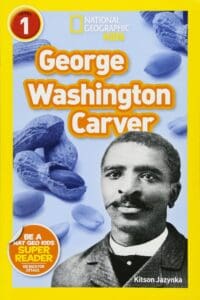
George Washington Carver National Geographic Reader
By Kitson Jazynka
Take a bite into the fascinating history of peanut butter and the man who invented it. Through leveled text and engaging photos, kids meet George Washington Carver and learn about his important work with peanuts and other plants. This level 1 reader is carefully leveled for an early independent reading or read aloud experience, perfect to encourage the scientists and explorers of tomorrow!
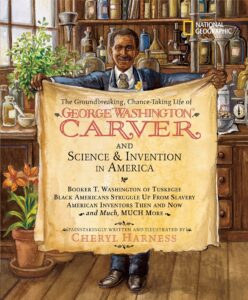
The Groundbreaking, Chance-Taking Life of George Washington Carver and Science and Invention
By Cheryl Harness
This is the inspiring story of a man who rose from slavery to worldwide fame as America’s Plant Doctor. Follow the action as Confederate raiders kidnap young Carver-along with his mother and siblings-and sell them to Arkansas slaveholders. Here, whooping cough threatens George’s life, yet the disease will be the key to his future. Unable to work in the fields, he spends his days studying plants. His desire for knowledge leads him to the rich farmlands of Iowa, where he becomes the first black student-and later the first black faculty member-at the state university.
Carver pioneers hundreds of new uses for plants and revolutionizes American agriculture by teaching farmers the value of rotating cotton with nitrogen-rich crops. Our hero dines at the White House, works with Henry Ford, and testifies to Congress. The book’s vivid illustrations are an invitation to step back in time and become an active participant in this compelling story.

George Washington Carver: More Than “The Peanut Man”
By Janet Rodriquez, Illustrated by Subi Bosa
Born enslaved during the Civil War in Diamond, Missouri, George Washington Carver was an agricultural scientist and inventor. He promoted alternative crops to cotton and methods to prevent soil depletion. Among his many accomplishments, he developed more than 300 industrial and commercial products from peanuts. It is time to remember how George Washington Carver’s inventions and his contributions changed our society… and our world! 8-10 years
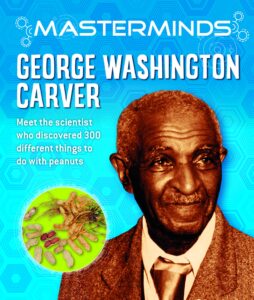
Masterminds: George Washington Carver
By Izzi Howell
George Washington Carver was born a slave, but became one of the most prominent scientists and inventors in U.S. history. As an agricultural scientist, Carver promoted the idea of growing peanuts and sweet potatoes to be used in over a hundred different ways. He also spent his time championing various efforts in agricultural education in the South. Masterminds readers how Carver, made massive contributions to his field and how his story and discoveries remain relevant today.

Fantastic Kids: George Washington Carver
By Michelle Jovin
George Washington Carver was born into slavery. No one thought much of him because he was sick and weak. He would spend his life proving them wrong. Learn more about the “Plant Doctor” turned “Peanut Man” and how he helped people across the United States. This biography includes a glossary and a table of contents to engage students in reading as they develop their comprehension and literacy skills. This book aligns with national and state standards and features TIME For Kids content to keep grade 2 students engaged in learning.
The book descriptions used are primarily from the publishers.
If you like this post, then please consider sharing it and/or leaving a comment below. Thank you! Barbara Lowell, Children’s Author
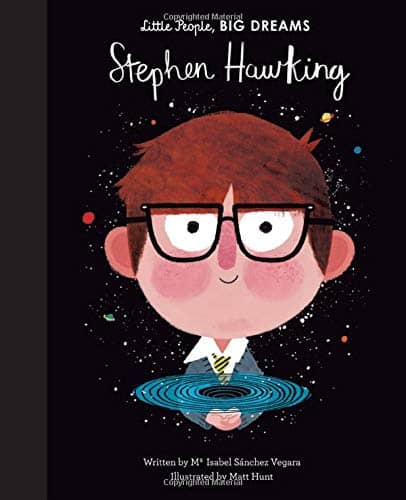
Stephen Hawking
By Maria Isabel Sanchez Vegara
When Stephen Hawking was a little boy, he used to stare up at the stars and wonder about the universe. Although he was never top of the class, his curiosity took him to the best universities in England, Oxford and Cambridge. It also led him to make one of the biggest scientific discoveries of the 20th century, Hawking radiation. This book features stylish and quirky illustrations and extra facts at the back, including a biographical timeline with historical photos and a detailed profile of the brilliant physicist’s life. 4-7 years

Stay Curious: A Brief History of Stephen Hawking
By Kathleen Krull, Illustrated by Paul Brewer
As a young boy, Stephen Hawking loved to read, stargaze, and figure out how things worked. He looked at the world and always asked, Why?
He never lost that curiosity, which led him to make groundbreaking discoveries about the universe as a young man. Even being diagnosed with ALS didn’t slow Stephen down. Those questions kept coming. As his body weakened, Stephen’s mind expanded allowing him to unlock secrets of the universe and become one of the most famous scientists of all time.
Stephen always approached life with courage, a sense of humor, and endless curiosity. His story will encourage readers to look at the world around them with new eyes. 4-8 years
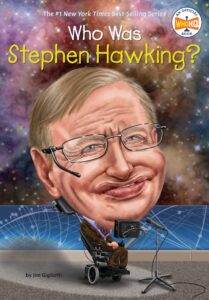
Who Was Stephen Hawking?
By Jim Gigliotti, Illustrated by Gregory Copeland
Stephen Hawking was born exactly three hundred years after the death of the scientist Galileo, so maybe it was written in the stars that he would become a famous scientist in his own right. Although he was diagnosed with a neurological disease at age 21, Stephen did not let the illness define his life.
Known for his groundbreaking work in physics, and identified by his wheelchair and computerized voice system, Stephen continued his research until his death in 2018. He is best known for his black hole theories and his best-selling book A Brief History of Time. Stephen Hawking is an example of a person who had a great mind, but an even greater spirit. 8-12 years
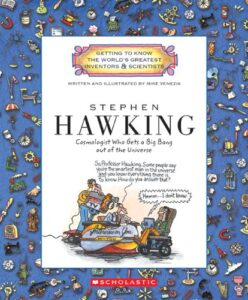
Stephen Hawking: Cosmologist Who Gets a Big Bang Out of the Universe
By Mike Venezia
Meet renowned physicist Stephen Hawking. This book presents the life and work of the British physicist who overcame the challenges of ALS to become one of the foremost scientists of the twentieth century.
This book combines a mix of historical reproductions, photos, and cartoon-style illustrations that bring to life Stephen Hawking’s work and contributions. 6-10 years

All About Stephen Hawking
By Chris Edwards, Illustrated by Amber Calderon
As an Oxford student, Stephen Hawking never expected that people across the world would know his name, or that his hobby of stargazing would lead him to be one of the world’s greatest scientists. Stephen Hawking made cosmology, or the study of the universe, accessible to everyone.
He was diagnosed with amyotrophic lateral sclerosis (ALS) at the age of twenty-one, but didn’t let that stop him from receiving a graduate degree from Cambridge and going on to be an expert in the scientific origin of the universe and black holes. Hawking is best known for writing A Brief History of Time, which explained cosmology in non-scientific terms so that non-scientists could understand it. 10-12 years
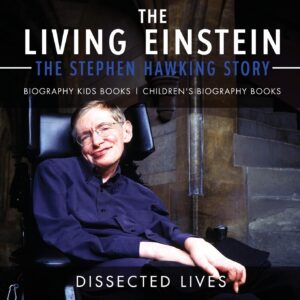
The Living Einstein: The Stephen Hawking Story
By Dissected Lives
Despite his debilitating illness, Stephen Hawking found ways to share his knowledge of the universe. He was a bright man who was always hungry for knowledge. He experimented, studied and explored anything and everything from the physical world to the cosmos. Be inspired by his story. Learn from his discoveries. 8-12 years
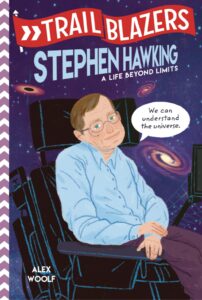
Stephen Hawking: A Life Beyond Limits
By Alex Woolf
In 1974, Stephen Hawking shook the world of physics. His theory on black holes went against everything the science community accepted as fact. How did he make such revolutionary discoveries? From a childhood spent building model airplanes to recognition as one of the greatest scientists of his time, Stephen’s genius and endless curiosity powered his work. Find out how this boy who loved science became one of history’s greatest trailblazers! 8-13 years
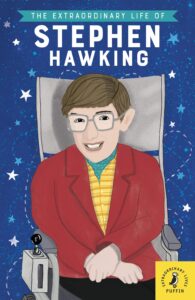
The Extraordinary Life of Stephen Hawking
By Kate Scott, Illustrating by Ester Mols
Stephen Hawking was: a physicist, a cosmologist, an author and one of the cleverest people who ever lived. While studying at Oxford University, Stephen Hawking was diagnosed with motor neurone disease, which meant that eventually he was completely paralyzed, and could only talk via a computer.
But that never held him back, and because of his work on time and space, he changed the way the world thinks about the universe.
Discover more about the life of a man who is known for his incredible contribution to science. 7-12 years
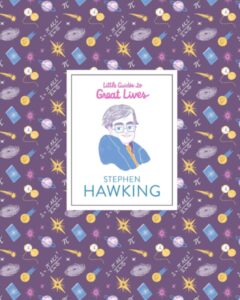
Little Guides to Great Lives: Stephen Hawkings
By Isabel Thomas, Illustrated by Marianna Madiz
Stephen Hawking was one of the world’s most renowned scientists and cosmologists. His ground–breaking research into black holes and the Big Bang has helped to explain the beginnings of our universe and his book A Brief History of Time has sold over 10 million copies. Diagnosed with a form of motor neuron disease when he was a young man, Stephen was inspired to achieve his goals as fast as possible. Through incredible determination and skill, he became a legendary scientist, a best–selling author, and the man that changed the way we think about the universe.
The book descriptions used are primarily from the publishers.
If you like this post, then please consider sharing it and/or leaving a comment below. Thank you! Barbara Lowell, Children’s Author

Electrical Wizard: How Nikola Tesla Lit Up the World
By Elizabeth Rusch, Illustrated by Oliver Dominguez
Here is the story of the ambitious young man who brought life-changing ideas to America, despite the obstructive efforts of his hero-turned-rival, Thomas Edison. From using alternating current to light up the Chicago World’s Fair to harnessing Niagara Falls to electrify New York City and beyond, Nikola Tesla was a revolutionary ahead of his time. Elizabeth Rusch sheds light on this extraordinary figure, while fine artist Oliver Dominguez brings his life and inventions to vivid color. Back matter includes additional information about Tesla, scientific notes and explanations, source notes, a bibliography, and suggestions for further reading. 8-12 years
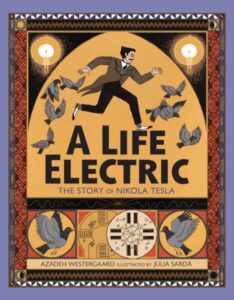
A Life Electric: The Story of Nikola Tesla
By Azadeh Westergaard, Illustrated by Júlia Sardà
Born at the stroke of midnight during a lightning storm, Nikola Tesla grew up to become one of the most important electrical inventors in the world. But before working with electricity, he was a child who loved playing with the animals on his family’s farm in Serbia.
An inventor since childhood, Tesla’s patents encompassed everything from radar and remote-control technology to wireless communications. But his greatest invention was the AC induction motor, which used alternating currents ( AC) to distribute electricity and which remains the standard for electric distribution today. Tesla’s love of animals also remained constant throughout his life and led to his anointment as the Pigeon Charmer of New York for his devotion to nature’s original wireless messengers. 5-9 years
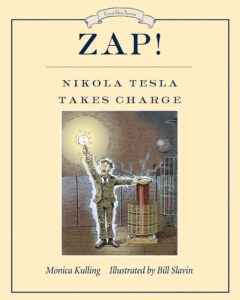
Zap! Nikola Tesla Takes the Charge
By Monica Kulling, Illustrated by Bill Slavin
Growing up in Smiljan, Croatia, Nikola Tesla dreamed about harnessing the power of Niagara Falls. In 1884, he walked down the gangplank onto New York Harbor with four cents in his pocket, a book of poems, a drawing of a flying machine, and a letter of introduction to Thomas Edison, the “electrical wizard” of America. Upon meeting, Edison sent Tesla to fix the SS Oregon as a test and was so astounded that he offered Tesla a job at his factory.
Tesla and Edison had different views about electricity. Tesla wanted to develop an alternate current while Edison wanted to stick to the direct current system. Edison offered Tesla a large sum to make his direct current system more efficient, but when the work was done, Edison refused to pay. Tesla quit and when things were looking bleak, he met George Westinghouse, who also thought that alternating current was the way to light up America. He gave Tesla a job and in 1896, Tesla and Westinghouse built a generator at Niagara Falls that was able to send power as far as Buffalo, New York. 5-8 years
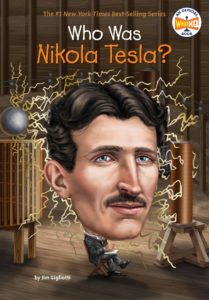
Who Was Nikola Tesla?
By Jim Giglotti, Illustrated by John Hinderliter
When Nikola Tesla arrived in the United States in 1884, he didn’t have much money, but he did have a letter of introduction to renowned inventor Thomas Edison. The working relationship between the two men was short lived. The two scientist-inventors became harsh competitors. One of the most influential scientists of all time, Nikola Tesla is celebrated for his experiments in electricity, X-rays, remote controls, and wireless communications. His invention of the Tesla coil was instrumental in the development of radio technology. 8-12 years

Bright Dreams: The Brilliant Ideas of Nikola Tesla
By Tracy Dockray
Young Nikola Tesla got a shock when he rubbed his cat’s fur. That small spark lit his imagination forever. Covering his early years to his eventual success in the world of electricity, Bright Dreams showcases Tesla’s incredible journey of discovery and perseverance. Author-illustrator Tracy Dockray conveys Tesla’s busy and imaginative world with collage-style artwork and informative sidebars. 8-11 years
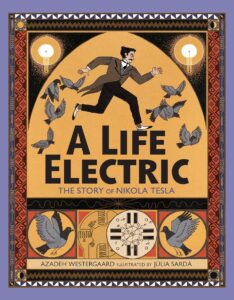
A Life Electric: The Story of Nikola Tesla
By Azadeh Westergaard, Illustrated by Júlia Sardá
Born at the stroke of midnight during a lightning storm, Nikola Tesla grew up to become one of the most important electrical inventors in the world. But before working with electricity, he was a child who loved playing with the animals on his family’s farm in Serbia.
An inventor since childhood, Tesla’s patents encompassed everything from radar and remote-control technology to wireless communications. But his greatest invention was the AC induction motor, which used alternating currents ( AC) to distribute electricity and which remains the standard for electric distribution today. Tesla’s love of animals also remained constant throughout his life and led to his anointment as the Pigeon Charmer of New York for his devotion to nature’s original wireless messengers. 5-9 years Forthcoming July 2021

Nikola Tesla For Kids: His Life, Ideas and Inventions
with 21 Activities
By Amy M. O’Quinn
Nikola Tesla was a physicist, scientist, electrical engineer, and world-renowned inventor whose accomplishments faded into oblivion after his death in 1943. Tesla was undeniably eccentric and compulsive; some considered him to be somewhat of a “mad” scientist. But in reality, he was a visionary. Many of his ideas and inventions that were deemed impossible during his lifetime have since become reality.
He was the first to successfully use rotating magnetic fields to create an AC (alternating current) electrical power supply system and induction motor. He is now acknowledged to have invented the radio ahead of Marconi. Among other things, he developed the Tesla coil, an oscillator, generators, fluorescent tubes, neon lights, and a small remote-controlled boat. He helped design the world’s first hydroelectric plant at Niagara Falls. This is the story of his life and ideas, complete with a timeline, 21 hands-on activities, and additional resources to better understand his many accomplishments. 9 and up.
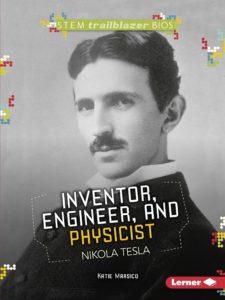
Inventor, Engineer, and Physicist Nikola Tesla
By Katie Marsico
Have you ever tried to invent something? As a child, Nikola Tesla saw a picture of a waterfall and imagined an invention that would turn the water’s energy into electricity. Later, he invented a waterwheel which turned water power into usable energy. As a young adult, Tesla spent his spare time experimenting with electrical equipment. He worked for inventor Thomas Edison, improving power plants and machines that ran on direct current electricity. But Tesla believed electrical distribution could be better. He went on to invent alternating current electricity, which would allow people to distribute electricity over long distances. Learn how Tesla’s work eventually made turning on electrical devices as easy as flipping a switch! 7-11 years
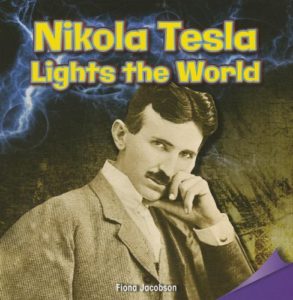
Nicola Tesla Lights the World
By Fiona Jacobson
Young readers will explore the life and work of Nikola Tesla, one the brightest inventors in history in this biography aligned to third grade Common Core Standards. 7-9 years
The book descriptions used are primarily from the publishers.
If you like this post, then please consider sharing it and/or leaving a comment below. Thank you! Barbara Lowell, Children’s Author
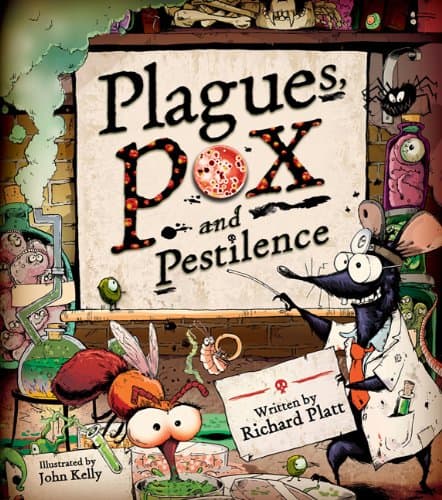
Plagues, Pox, and Pestilence
By Richard Platt , Illustrated by John Kelly
Plagues, Pox, and Pestilence is a history of disease, and pestilence, told from the point of view of the bugs and pests that cause them. This book features case histories of epidemics and eyewitness accounts from the rats, flies, ticks and creepy-crawlies who spread diseases. There are lots of fascinating facts and figures on the biggest and worst afflictions. 7-12 years

Outbreak! Plagues That Changed History
By Bryn Barnard
Filled with fascinating, often gory details about disease and history, Outbreak! is the combination of science and history.
Did the Black Death destroy medieval Europe? Did cholera pave the way for modern Manhattan? Did yellow fever help end the slave trade? Remarkably, the answer to all of these questions is yes. Time and again, diseases have impacted the course of human history in surprisingly powerful ways. Bryn Barnard describes the symptoms and paths of the world’s worst diseases—and how the epidemics they spawned have changed history forever. 8-12 years

Epidemic, Pandemic, Should I Call the Medic?
By Baby Professor
What is the difference between epidemics and pandemics? Learn the difference and more in this biology book for kids. 6 and up
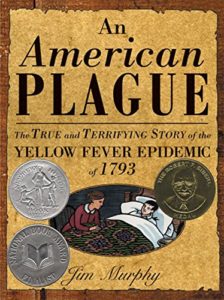
An American Plague:
The True and Terrifying Story of the Yellow Fever Epidemic of 1793
By Jim Murphy
In 1793, Philadelphia was the nation’s capital and the largest city in North America. It’s devastated by an apparently incurable disease, its cause unknown.
Jim Murphy describes the illness known as yellow fever. It took a toll on the city’s residents. He relates the epidemic to the major social and political events of the day and to 18th-century medical beliefs and practices. Drawing on first-hand accounts, he spotlights the heroic role of Philadelphia’s free blacks in combating the epidemic. And the Constitutional crisis that President Washington faced when he was forced to leave the city while escaping the deadly contagion. The search for the fever’s causes and cure, not found for more than a century afterward, provides a suspenseful counterpoint to this story of a city under siege. 10-12 years
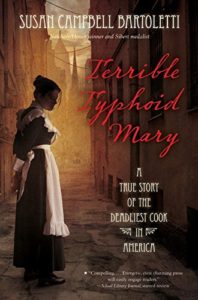
Terrible Typhoid Mary: A True Story of the Deadliest Cook in America
By Susan Campbell Bartoletti
What happens when a person’s reputation has been forever damaged? With archival photographs and text among other primary sources, this biography of Mary Mallon looks beyond the tabloid scandal of Mary’s controversial life. How she was treated by medical and legal officials reveals a lesser-known story of human and constitutional rights. It’s entangled with the science of pathology and the enduring questions about who Mary Mallon really was. How did her name become synonymous with deadly disease? And who is really responsible for the lasting legacy of Typhoid Mary? This exploration includes an author’s note, timeline, annotated source notes, and bibliography. 12 and up
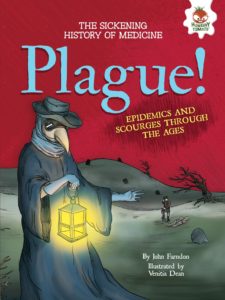
Plague! Epidemics, and Scourges Through the Ages
By John Farndon, Illustrated by Venitia Dean
Being sick is horrible. But it used to be worse. Inside this book, you’ll see evidence of the plagues of the past―rotting skin, dissolving lungs, and sinister swelling all over the body. Diseases like the Black Death wiped out whole towns and villages. Tuberculosis consumed young people like a bloodsucking vampire. And Smallpox left its victims scarred for life―if they survived. At the time, no one knew where these killer diseases came from or how to treat them. But eventually doctors discovered how these diseases and others were spread. Being sick isn’t quite as sickening as it was in the past! 8-12 years

Purple Death
By David Getz
The Spanish Flu was one of the worst epidemics in this country’s history, and the search for its cause is still one of science’s most urgent quests. David Getz tells young readers the story of the mysterious flu known as the Purple Death―the virus responsible for the worst epidemic in American history.
It was 1918, the last year of World War I. Thousands of men lived in crowded army training camps that were scattered all across the United States. That spring, a strange flu struck the soldiers at a camp in the Midwest. Healthy young men went to the hospital complaining of sore throats and fevers. Within hours they had suffocated, their skin taking on a terrible purplish hue.
The devastating flu spread like wildfire across the country, infecting soldiers and civilians alike. It killed more than half a million people in a matter of months, then disappeared as suddenly as it had come.
To this day, no one knows what caused a common flu to become so deadly, but scientists are still searching for answers. What they discover could save millions of lives if another common flu virus suddenly turns into a killer. 7-10 years

Fever 1793
By Laurie Halse Anderson
An epidemic of fever sweeps through the streets of Philadelphia.
During the summer of 1793, Mattie Cook lives above the family coffee shop with her widowed mother and grandfather. Mattie spends her days avoiding chores and making plans to turn the family business into the finest Philadelphia has ever seen. But then the fever breaks out.
The epidemic sweeps the streets, destroying everything in its path and turning Mattie’s world upside down. At her feverish mother’s insistence, Mattie flees the city with her grandfather. But she soon discovers that the sickness is everywhere, and Mattie must learn quickly how to survive in a city turned frantic with disease.
The book descriptions used are primarily from the publishers.
If you like this post, then please consider sharing it and/or leaving a comment below. Thank you! Barbara Lowell, Children’s Author

Look Up With Me: Neil deGrasse Tyson: A Life Among the Stars
By Jennifer Berne, Illustrated by Lorraine Nam
Neil deGrasse Tyson was born curious. And the secrets of a billion galaxies lay there—waiting for him to explore its cosmic mysteries. He just had to look up. Up beyond the city lights, up at the shining stars, up through the Milky Way, and past the veil of the night sky.
Follow young Neil’s journey as he discovers the wonders of space, the thrill of science, and the joy in sharing the beauty of our amazing universe. Read his favorite mind-blowing facts and learn what mysteries are left to solve.

Astrophysics for Young People in a Hurry
By Neil deGrasse Tyson with Gregory Mone
From the basics of physics to big questions about the nature of space and time, celebrated astrophysicist and science communicator Neil deGrasse Tyson breaks down the mysteries of the cosmos into bite-sized pieces. Astrophysics for Young People in a Hurry describes the fundamental rules and unknowns of our universe clearly — and with Tyson’s characteristic wit, there’s a lot of fun thrown in, too.
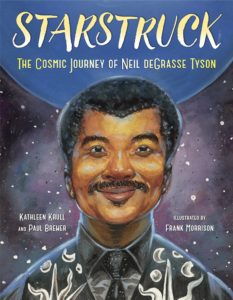
Starstuck: The Cosmic Journey of Neil deGrasse Tyson
By Kathleen Krull and Paul Brewer, Illustrated by Frank Morrison
Young Neil deGrasse Tyson was starstruck when he first visited the sky theater at the Hayden Planetarium in New York City. He couldn’t believe the crowded, glittering night sky at the planetarium was real–until a visit to the country years later revealed the impossible.
That discovery was like rocket fuel for Neil’s passion about space. His quest for knowledge took him from the roof of his apartment building, to a science expedition in northwest Africa, to a summer astronomy camp beneath a desert sky, and finally back home to become the director of the Hayden Planetarium, where it all began. Before long, Neil became America’s favorite guide to the cosmos.
This story of how one boy’s quest for knowledge about space leads him to become a star scientist is perfect for young readers who are fascinated by the universe, aspiring scientists, and the dreamer in all of us. It will ignite your own sense of wonder.
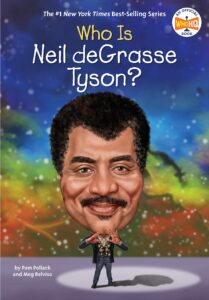
Who Is Neil deGrasse Tyson?
By Pam Pollack and Meg Belviso, Illustrated by Manuel Gutierrez
When he was nine years old, Neil deGrasse Tyson went on a trip that would change his life. While visiting the Hayden Planetarium at the Museum of Natural History in New York City, he discovered the world of astronomy and felt like the universe was calling to him. He answered that call by diving deep into astronomy courses. After graduating from the Bronx High School of Science, he went on to earn a doctorate in astrophysics and eventually found his way back to the Hayden Planetarium as a staff scientist and, later, as its director.
Neil has not only found an exciting way to share his love and knowledge of space through his documentaries and podcasts, he’s also broken barriers for Black scientists and become one of the most famous astrophysicists ever. He is a published author, television host, and winner of the prestigious Public Welfare Medal for the role he has played in exciting the public about the wonders of science. 8-12 years
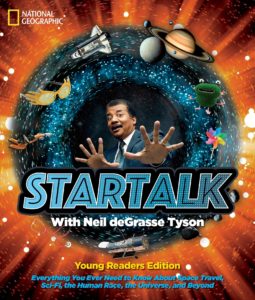
Star Talk With Neil deGrasse Tyson:Young Readers Edition
by Neil deGrasse Tyson with Charles Lu
For decades, beloved astrophysicist Neil deGrasse Tyson has interpreted science with a combination of brainpower and charm that resonates with fans everywhere. In 2009, he founded StarTalk, the wildly popular podcast that became an Emmy-nominated talk show on the National Geographic Channel in 2015. His pioneering book takes the greatest hits from the airwaves to the page in one smart, richly illustrated compendium for young adult readers.
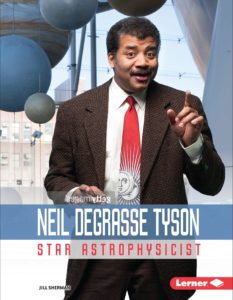
Neil deGrasse Tyson: Star Astrophysicist
By Jill Sherman
In addition to speaking about challenging scientific topics for a variety of news sources, Neil deGrasse Tyson is director of a New York planetarium, hosts a science podcast, and has a following of more than three million on Twitter. Learn about his personal and professional life. He’s arguably the most famous astrophysicist in the modern world.
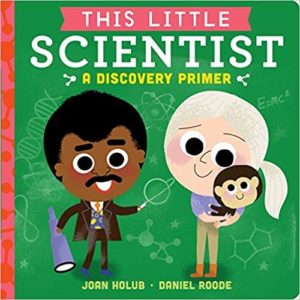
This Little Scientist, A Discovery Primer
By Joan Holub, Illustrated by Daniel Roode
Learn all about scientists who changed history in this engaging and colorful board book perfect for inventors-in-training!
Asking why.
Then making a guess.
Asking how.
Then proving with tests.
Little scientists make great big discoveries.
Now even the youngest readers can learn all about great and empowering scientists in history! Highlighting ten memorable scientists who paved the way, parents and little ones alike will love this discovery primer full of fun, age-appropriate facts and bold illustrations.
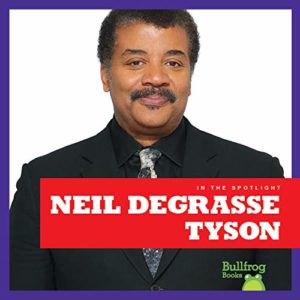
Neil deGrasse Tyson
By Kaitlyn Duling
In this book, early readers will learn about the life, accomplishments and contributions of astrophysicist Neil deGrasse Tyson. Leveled text will engage emergent readers as they learn about his life.
The book descriptions used are primarily from the publishers.
If you like this post, then please consider sharing it and/or leaving a comment below. Thank you! Barbara Lowell, Children’s Author
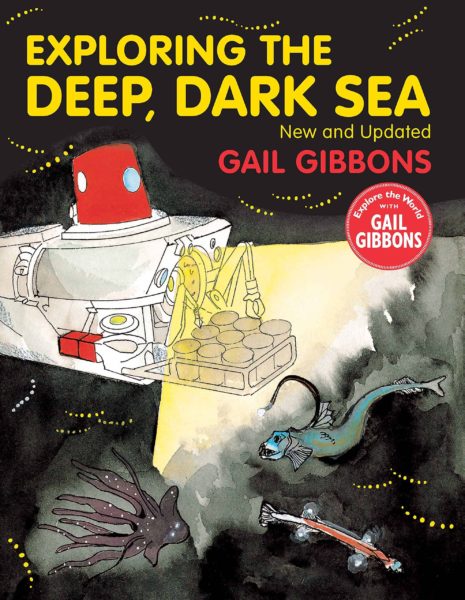
Eight books for kids about exploring the ocean.
Exploring the Deep, Dark Sea
By Gail Gibbons
Dive deep with Gail Gibbons as she explains the mechanics and discoveries of deep-sea exploration. The surface of the moon is more familiar to us than the deep sea of our own planet. Many oceanographers are trying to change that. To explore the deep sea, they climb into submersibles and employ ROVs to find out more about the ocean and ocean floor. Gibbons invites readers along for a journey to the deep sea, explaining the technology for exploration and kinds of animals found at different sea levels. 4-8 years

Flying Deep: Climb Inside Deep-Sea Submersible Alvin
By Michelle Cusolito, Illustrated by Nicole Wong
Climb aboard Alvin, the famous deep-sea submersible credited with helping to find the Titanic, and take a trip two miles down to the bottom of the ocean. Experience a day in the life of an Alvin pilot and join scientists at the seafloor to collect samples and conduct research. Along the way, discover what one wears, eats, and talks about during a typical eight-hour trip in a underwater craft and find out more about the animals that live deep in our oceans. Extensive back matter explains how Alvin works, describes the author’s research, and includes a glossary and further reading. 5-9 years
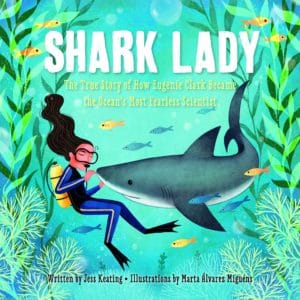
Shark Lady: The True Story of How Eugenie Clark Became the Ocean’s Most Fearless Scientist
By Jess Keating, Illustrated by Marta Alvarez Miguens
Eugenie Clark fell in love with sharks from the first moment she saw them at the aquarium. She couldn’t imagine anything more exciting than studying these graceful creatures. But Eugenie quickly discovered that many people believed sharks to be ugly and scary — and they didn’t think women should be scientists.
Determined to prove them wrong, Eugenie devoted her life to learning about sharks. Like Jack and the Beanstalk but under the sea, Eugenie dove down to discover a world of wonder beneath the water’s surface. She earned the name Shark Lady with her many discoveries about these beautiful creatures. Through her accomplishments, this star girl of the sea taught the world that sharks should be admired, not feared, and that women can do anything they set their minds to. 4-8 years
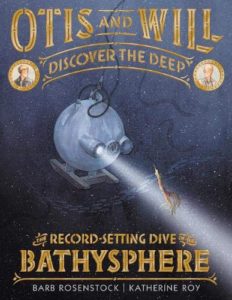
Otis and Will Discover the Deep
By Barb Rosenstock, Illustrated by Katherine Roy
On June 6, 1930, engineer Otis Barton and explorer Will Beebe dove into the ocean inside a hollow metal ball of their own invention called the Bathysphere. They knew dozens of things might go wrong. A tiny leak could shoot pressurized water straight through the men like bullets. A single spark could cause their oxygen tanks to explode. No one had ever dived lower than a few hundred feet…and come back. But Otis and Will were determined to become the first people to see what the deep ocean looks like. 6-9 years
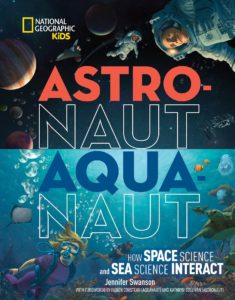
Astronaut-Aquanaut: How Space Science and Sea Science Interact
By Jennifer Swanson
Journey from the deepest trenches in the oceans to the farthest humans have ventured into space and learn what it takes to explore the extremes. You might just be surprised by how similar the domains of astronauts and aquanauts really are. Space and the ocean — if you don’t think they go together, think again. Both deep-sea and space explorers have to worry about pressure, temperature, climate, and most importantly, how to survive in a remote and hostile environment. Join us on an amazing journey as we go up in space with astronauts and dive deep down in the ocean with aquanauts to explore the far-off places of our planet and the solar system. 8-12 years

The Brilliant Deep: Rebuilding the World’s Coral Reefs The Story of Ken Nedimyer and the Coral Reef Restoration Foundation
By Kate Messner, Illustrated by Matthew Forsythe
All it takes is one: one coral gamete to start a colony, one person to make a difference, one idea to change the world. The ongoing efforts to save and rebuild the world’s coral reefs — with hammer and glue and grafts of newly grown coral — and the living legacy of Ken Nedimyer, founder of the Coral Restoration Foundation. This is the story of the coral restoration pioneer in this brilliant tribute to the wonders of nature and the power of human hope. 6-9 years
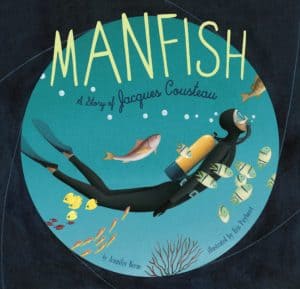
Manfish: A Story of Jacques Cousteau
By Jennifer Berne, Illustrated by Eric Puybaret
Once upon a time in France, a baby was born under the summer sun. His parents named him Jacques. As he grew, Jacques fell in love with the sea. He dreamed of breathing beneath the waves and swimming as gracefully as a fish. In fact, he longed to become a manfish. Jacques Cousteau grew up to become a champion of the seas and one of the best-know oceanographers in the world. 6-9 years

Diving with Sharks
By Margaret Gurevich
Fans of Shark Week, Sharknado, and all things shark-related will want to sink their teeth into this exciting shark-infested chapter book. Join real-life cave divers, extreme photographers, and researchers as they brave thrilling undersea adventures. 7-10 years
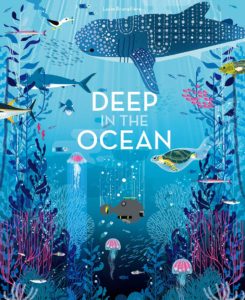
Deep in the Ocean
By Lucie Brunelliere
A scientific team has boarded the submarine Oceanos to explore the ocean’s depths. Suddenly, it gets caught in a violent storm, causing it to drift thousands of miles off-course. From the glittering surface of the sea to the darkness of the abyss. Deep in the Ocean takes readers on a bewitching journey through fascinating waters — some warm, colorful, and crowded with sea creatures, others mysterious and turbulent. 3-5 years Board Book
The book descriptions used are primarily from the publishers.
If you like this post, then please consider sharing it and/or leaving a comment below. Thank you! Barbara Lowell, Children’s Author

Timeless Thomas: How Thomas Edison Changed Our Lives
By Gene Barretta
What do record players, batteries, and movie cameras have in common? All these devices were created by the man known as “The Wizard of Menlo Park,” Thomas Edison. He is most famous for inventing the incandescent light bulb. But at his landmark laboratories in Menlo Park and West Orange, New Jersey, he developed other staples of modern technology. He persevered despite many failures. We are lucky that he did because it would be very difficult to go through a day without using one of his life-changing inventions. 6-10 years

A Wizard From the Start: The Incredible Boyhood and Amazing Inventions of Thomas Edison
By Don Brown
A wizard from the start, Thomas Edison had a thirst for knowledge, taste for mischief, and hunger for discovery—but his success was made possible by his boundless energy. At age fourteen he coined his personal motto: “The More to do, the more to be done,” and then went out and did: picking up skills and knowledge at every turn. When learning about things that existed wasn’t enough, he dreamed up new inventions to improve the world. From humble beginnings as a farmer’s son, selling newspapers on trains and reading through public libraries shelf by shelf, Tom began his inventing career as a boy and became a legend as a man. 4-7 years

When Thomas Edison Fed Someone Worms
By Mark Andrew Weakland, Illustrated by Thomas Radcliffe
Thomas Edison became a great American inventor and businessman. But do you know what he was like as a child? From exploring shipyards and pastures to feeding a girl worms, Thomas was a curious and creative child. This playful story of his childhood will help young readers connect with a historic figure and will inspire them to want to achieve greatness. 6-8 years
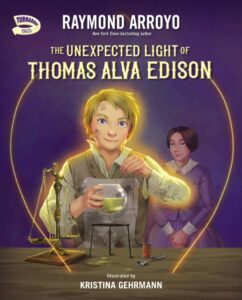
The Unexpected Light of Thomas Alva Edison
By Raymond Arroyo, Illustrated by Kristina Gehrmann
No one thought much of young Thomas Alva Edison. He couldn’t focus at school and caused trouble around the house. But where others saw a distracted and mischievous boy, his mother saw imagination and curiosity. At only seven years old, Al, as he was called as a young child, was educated by his mother, who oversaw his rigorous at-home education while also allowing him great freedom to explore and dream. Those early years of encouragement and loving guidance formed the man who would apply those valuable lessons as well as his rich imagination to inventing the phonograph, the motion picture camera, the light bulb, and more. 4-8 years
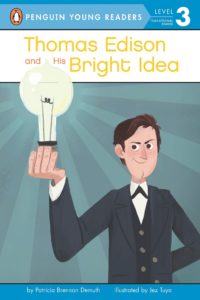
Thomas Edison and His Bright Idea
By Patricia Brennan Demuth, Illustrated by Jez Tuya
This nonfiction reader shines a light on Thomas Edison and his greatest invention — the light bulb! As a curious child who was always asking questions, it’s no wonder he grew up to become a famous, prolific inventor. This story follows Edison from his time in school to his career as full-time inventor. His discoveries will fascinate and inspire all curious young minds. 6-8 years
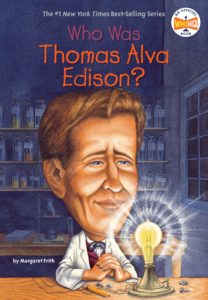
Who Was Thomas Edison?
By Margaret Frith, Illustrated by John O’Brien
One day in 1882, Thomas Edison flipped a switch that lit up lower Manhattan with incandescent light and changed the way people lived. The electric light bulb was only one of thousands of Edison’s inventions. As a boy, observing a robin catch a worm and then take flight, he fed a playmate a mixture of worms and water to see if she could fly. 8-12 years

Thomas Edison Lighting the Way
By Lori Haskins Houran, Illustrated by Gustavo Mazali
Most people today know Thomas Edison as the inventor of the light bulb—except, he isn’t! In Edison’s time, other inventors were working on the light bulb, but no one could figure out how to keep the light bulb lit. This is where Edison came in. Read and find out all about the real story of Thomas Edison’s life and his many amazing inventions, like the movie camera and the battery for an electric car! Biography reader includes a timeline and historical photos all about the life of this inspiring figure. 4-8 years
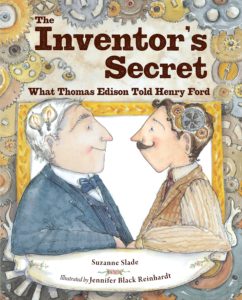
The Inventor’s Secret: What Thomas Edison Told Henry Ford
By Suzanne Slade, Illustrated Jennifer Black Reinhardt
Thomas Edison and Henry Ford started off as insatiably curious tinkerers. That curiosity led them to become inventors — with very different results. As Edison invented hit after commercial hit, gaining fame and fortune, Henry struggled to make a single invention, an affordable car, work. Witnessing Thomas’s glorious career from afar, a frustrated Henry wondered about the secret to his success. This little-known story is a fresh, kid-friendly way to show how they grew up to be the most famous inventors in the world and best friends, too. 6-9 years

Young Thomas Edison
By Michael Dooling
How did Thomas Edison grow up to be America’s greatest inventor? This book explores the beginnings of his genius from his difficulty in school, to his early years as a young scientist, to the man everyone called, “The Wizard of Menlo Park.” 7 and up
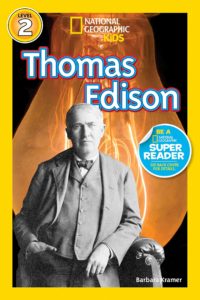
National Geographic Readers: Thomas Edison
By Barbara Kramer
Learn all about Thomas Edison, one of the most important figures in American history, in this leveled reader written in an easy-to-grasp style that will encourage the inventors of tomorrow! 5-8 years
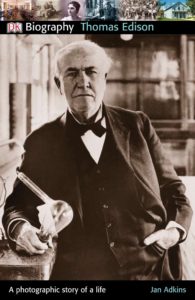
DK Biography Thomas Edison: A Photographic Story of a Life
By Jan Adkins
Filled with archival photographs and amazing facts, this biography tells the story of the famous inventor, from his childhood as an “addled” student, to his reign as the “Wizard of Menlo Park,” where he developed the electric light bulb, the phonograph, and many other inventions still in use today. 10-17 years
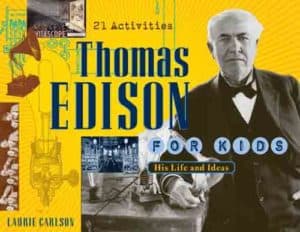
Thomas Edison For Kids: His Life and Ideas, 21 Activities
By Laurie Carlson
Thomas Edison, one of the world’s greatest inventors, is introduced in this activity books. Children will learn how he ushered in an astounding age of invention with his unique way of looking at things and his refusal to be satisfied with only one solution to a problem. This books helps to inspire kids to be inventors and scientists, as well as persevere with their own ideas. Activities allow children to try Edison’s experiments: making a puppet dance, using static electricity, manufacturing a switch for an electric current, constructing a telegraph machine, and many more. 9-12 years.
The book descriptions used are primarily from the publishers.
If you like this post, then please consider sharing it and leaving a comment below. Thank you! Barbara Lowell, Children’s Author

Me…Jane
By Patrick McDonnell
Patrick McDonnell tells the story of the young Jane Goodall and her special childhood toy chimpanzee named Jubilee. As the young Jane observes the natural world around her with wonder, she dreams of “a life living with and helping all animals,” until one day she finds that her dream has come true. With anecdotes taken directly from her autobiography, McDonnell makes this very true story accessible for the very young–and young at heart. 1-6 years

Chimpanzee Children of Gombe
By Jane Goodall, Photographs by Michael Neugebauer
This book is filled with photos of many of the chimpanzee babies, toddlers, and young adults that live in the Gombe National Park in Tanzania, where the Jane Goodall research center is located. Dr. Goodall has campaigned unceasingly for the protection of the chimpanzee—now an endangered species—and this moving, personal account will educate readers about the many threats to the animals in the wild and inspire readers of all ages to join in her vital work. 5-7 years
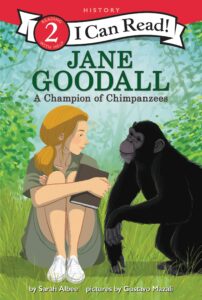
Jane Goodall: A Champion of Chimpanzees
By Sarah Albee, Illustrated by Gustavo Mazali
Learn about the life of Jane Goodall, a pioneering scientist who became the worlds expert on chimpanzees, in this early reader biography.
She was the first person to study wild chimpanzees up close in a rain forest. She befriended the chimps and discovered amazing facts about their behaviors. What she learned forever changed how people look at these animals.
Beginning readers will learn about the milestones in Jane Goodall’s life in this Level Two I Can Read biography. This biography includes a timeline and photos all about the life of this inspiring scientist. Preschool – 3rd Grade
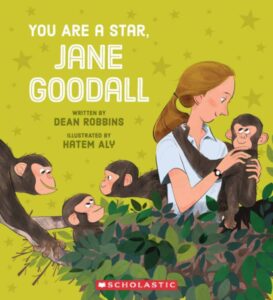
You Are a Star Jane Goodall
By Dean Robbins, Illustrated by Hatem Aly
Using a unique mix of first-person narrative, hilarious comic panels, and essential facts, Dean Robbins introduces young readers to an scientific trailblazer. You Are a Star, Jane Goodall focuses on Jane’s lifelong mission to understand the chimpanzees and protect the planet. Hatem Aly’s spot-on comic illustrations bring this icon to life, and back matter instructs readers on how to be more like Jane! 5-7 years

The Watcher: Jane Goodall’s Life with the Chimps
By Jeannette Winter
Follow Jane from her childhood in London watching a robin on her windowsill, to her years in the African forests of Gombe, Tanzania, invited by the brilliant scientist Louis Leakey to observe chimps, to her worldwide crusade to save these primates, who are now in danger of extinction. Young animal lovers will welcome this moving portrait of an extraordinary person and the animals to whom she has dedicated her life. 4-8 years
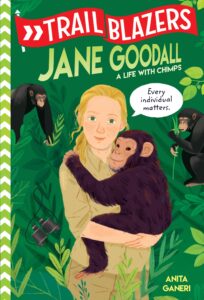
Jane Goodall: A Life with Chimpanzees
By Anita Ganeri
Bring history home and meet some of the world’s greatest game changers! Get inspired by the true story of a famous researcher who studied chimpanzees. This biography series is for kids who loved Who Was? and are ready for the next level.
In July 1960, Jane Goodall went into the wilderness in Tanzania to study chimpanzees. For years she camped out with the chimps, observing their behavior and making amazing discoveries! Jane had always been fascinated by animals and knew she wanted to make learning more about them her life’s work. Find out how this girl who loved animals became one of history’s greatest trailblazers! Grades 3-7
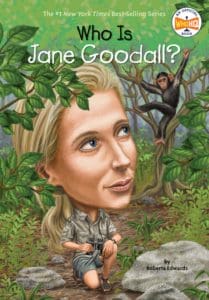
Who Is Jane Goodall?
By Roberta Edwards, Illustrated by John O’Brien
A life in the wild!
Jane Goodall, born in London, England, always loved animals and wanted to study them in their natural habitats. So at age twenty-six, off she went to Africa! Goodall’s up-close observations of chimpanzees changed what we know about them and paved the way for many female scientists who came after her. Now her story comes to life in this biography with black-and-white illustrations throughout. 8-12 years
Who Is Jane Goodall? A Board Book
By Lisbeth Kaiser, Illustrated by Stanley Chow
The chronology and themes of Jane Goodall’s meaningful life are presented in a masterfully succinct text, with just a few sentences per page. The fresh, stylized illustrations are sure to captivate young readers and adults alike. With a read-aloud biographical summary in the back, this age-appropriate introduction honors and shares the life and work of one of the most influential scientists of our time. 2-4 years
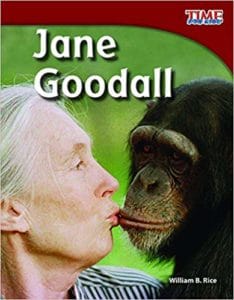
Jane Goodall: Biography for Kids
By William Rice
In 1900, an estimated 1 million chimpanzees lived in the wild. Today, there are only about 340,000. Jane Goodall spent years observing, interacting with, and studying chimpanzees. Her true story is in this easy-to-read, picture-filled biography for kids. She is a wonderful example of how to work hard and follow your dreams. 7-9 years
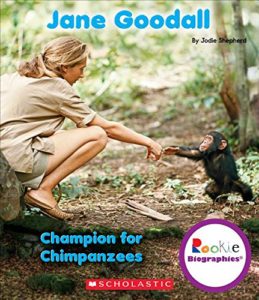
Jane Goodall Champion for Chimpanzees
By Jodie Shepherd
Jane Goodall loved animals from the time she was a young girl. She dreamed of going to Africa to see the wildlife that lived there. After getting her wish, Goodall went on to become one of the most respected primatologists in the world. Her many discoveries changed the way we look at and treat chimpanzees. 4-7 years
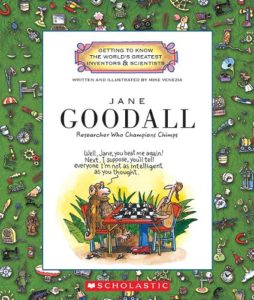
Jane Goodall: Researcher Who Champions Chimpanzees
By Mike Venezia
This biography of Jane Goodall is perfect for young readers, developing scientists, and critical thinkers. It contains cartoon-style illustrations to complement the easy-to-read text and full-color reproductions of sketches and notebooks. 7-9 years
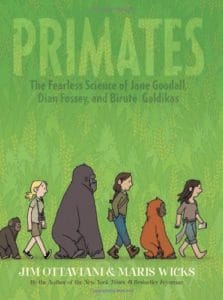
Primates: The Fearless Science of Jane Goodall, Dian Fossey and Birute Galdikas
By Jim Ottaivani, Illustrated by Maris Wicks
Jane Goodall, Dian Fossey and Birute Galdiakas were all students of the great Louis Leakey. Each made profound contributions to primatology―and to our own understanding of ourselves. Primates, a graphic novel, is an accessible, entertaining, and informative look at the field of primatology and at the lives of three of the most remarkable women scientists of the twentieth century. 12-18 years
The books descriptions used are primarily from the publishers.
If you like this post, then please consider sharing it and leaving a comment below. Thank you! Barbara Lowell, Children’s Author
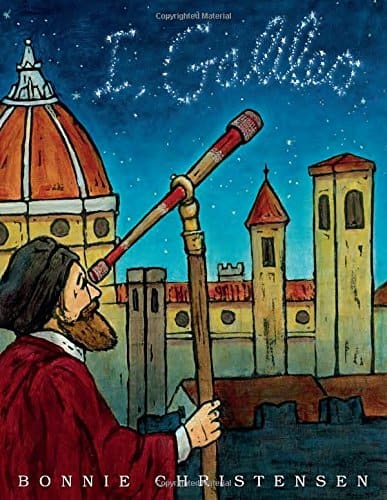
Galileo Galilei
I, Galileo
by Bonnie Christensen
Galileo’s contributions were numerous. They included the telescope and the microscope. And his ideas were world-changing especially the sun-centric solar system. Albert Einstein called him “the father of modern science.” But in his own time he was branded a heretic and imprisoned in his home. He was a man who insisted on his right to pursue the truth, no matter what the cost. This made his life as interesting and instructive as his ideas. 8-12 years

Starry Messenger
By Peter Sis
In every age there are courageous people who break with tradition to explore new ideas and challenge accepted truths. Galileo Galilei was just such a man, a genius, and the first to turn the telescope to the skies to map the heavens. In doing so, he offered objective evidence that the earth was not the fixed center of the universe but that it and all the other planets revolved around the sun. He kept careful notes and made beautiful drawings of all that he observed. Through his telescope he brought the stars down to earth for everyone to see. 6-10 years
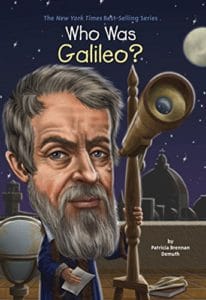
Who Was Galileo?
By Patricia Brennan Demuth, Illustrated by John O’Brien
Born in Pisa, Italy, in the sixteenth century, Galileo contributed to the era’s great rebirth of knowledge. He invented a telescope to observe the heavens. He turned long-held ideas about the universe topsy turvy with his support of a sun-centric solar system. This brilliant man lived in a time when speaking scientific truth to those in power was still a dangerous proposition. 8-12 years
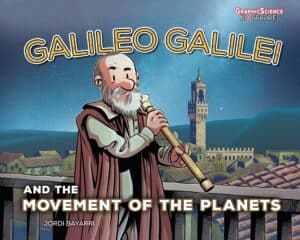
Galileo Galilei and the Movement of the Planets (Graphic Biography)
By Jordi Bayarri Dolz
Galileo Galilei believed in the power of scientific observation over traditional ideas. His close study of the night sky helped support the theory that planets move around the sun. His defiant personality made him powerful enemies. This graphic biography covers Galilei’s life from his early work with projectiles to his revolutionary look at the cosmos. It also depicts the backlash to his bold ideas and his trial under the Inquisition. 10-14 years
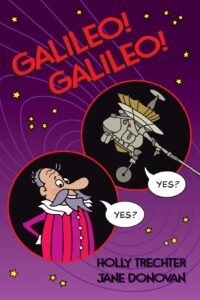
Galileo! Galileo!
By Holly Trechter and Jane Donovan
For hundreds of years, people have dreamed of Jupiter, the king of the planets. But the trip across the solar system is so long and dangerous that it seems almost impossible. This is the incredible, true story of NASA’s Galileo Mission. It’s narrated by the medieval genius Galileo, who connects with middle-grade readers in a humorous way. Strap in for this epic adventure of imagination, brilliance, and plain old grit. 8-12 years
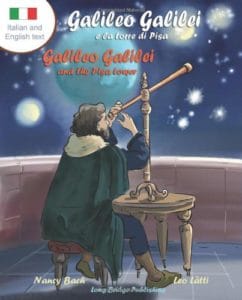
Galileo Galilei and the Pisa Tower:
A Bilingual Picture Book About the Italian Astonomer
(Italian and English Text)
By Nancy Bach, Illustrated by Leo Latti
Young readers and language learners will find this bilingual book easy to read and understand. This simple story introduces the Italian astronomer Galileo Galilei, his life, work and discoveries. All ages

Along Came Galileo
By Jeanne Bendick
One of the most important figures to come out of the awakening world of the Renaissance was Galileo Galilei. Often referred to as the “Archimedes of his time, Galileo was forever asking questions. Is it possible to measure heat? Is it possible to weigh air? Does the earth stand still or does it move? How fast do objects fall to the earth? His questions led to some of the most important answers of the scientific world and to his contributions to astronomy, physics, and mathematics. All ages
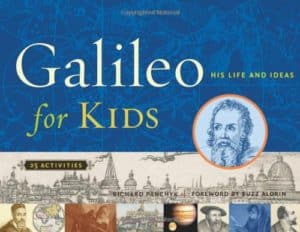
Galileo for Kids: His Life and Ideas, 25 Activities
By Richard Panchyk
Galileo, one of history’s best-known scientists, made revolutionary discoveries and proposed sometimes controversial theories that changed his world and laid the groundwork for modern astronomy and physics. The activities in this book allow children to try some of Galileo’s experiments on their own. 9 and up

Galileo’s Journal 1609-1610
By Jeanne Pettenati, Illustrated by Paolo Rui
On his summer vacation, Galileo Galilei hears about the newly invented telescope and decides to build one of his own. Turning his new “spyglass” to the night sky, he sees things that no one has ever seen before. He discovers that the Milky Way is made of stars, and that the moon has mountains. He notices a strange formation of “stars” that will eventually turn people’s understanding of the world upside down. Fictional journal accounts capture the famous Italian scientist’s curiosity and wonder as he makes some of the most amazing discoveries in history. 6-9 years
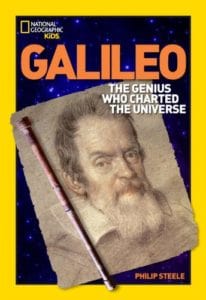
Galileo: The Genuis Who Charted the Universe
By Phillip Steele
Galileo made the first effective use of the refracting telescope to discover important new facts about astronomy. His observations led him to support Copernicus’s claim that Earth and the other planets circled the sun. His genius lay in the way he approached scientific problems. He reduced problems to simple terms on the basis of experience and common-sense logic. Then he analyzed and resolved the problems according to simple mathematical descriptions, opening the way for the development of modern mathematical physics. 8-12 years
The book descriptions used are primarily from the publishers.
If you like this post, then please consider sharing it and leaving a comment below. Thank you! Barbara Lowell, Children’s Author

































































































